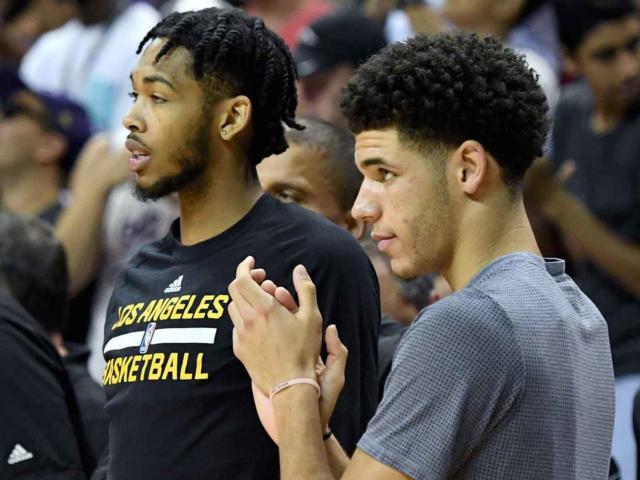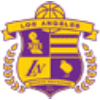The Los Angeles Lakers will soon resume the battle to rebound from the injury-plagued end to Kobe Bryant’s career and the difficult aftermath. They finally awoke from what seemed like a very bad dream to discover that the world has drastically changed: Free agents no longer care about their 16 banners or the wonderful weather in Southern California, they want to play with other top stars and win titles.
Lacking assets to make a major trade, the Lakers did the only thing they could do which was rebuild through the draft. It started with Julius Randle and Jordan Clarkson in 2014. D’Angelo Russell, Larry Nance, Jr. and Anthony Brown arrived in 2015, followed by Brandon Ingram and Ivica Zubac in 2016. This year, Lonzo Ball, Kyle Kuzma, Josh Hart and Thomas Bryant joined the team.
Of course not everyone has lasted as both Brown and Russell are both no longer with the team.
The Lakers are not alone in this process, however. At least three other franchises have been in the same predicament and pursued this same strategy, which makes it only natural for the Lakers to be compared to, and their progress measured against, these other teams.
First, there is the Minnesota Timberwolves, who finished 13th in the Western Conference last season with a record of 31-51. They feature two young players who went number one in their respective draft classes, Andrew Wiggins and Karl Anthony Towns. Last year they also featured high flying Zach LaVine (drafted 2014) and point guard Kris Dunn (2016) who many predicted would be Rookie of the Year last season.
The Timberwolves trumped the competition this summer by making the kind of bold move that instantly alters a team’s fortunes. Minnesota shocked the basketball world by trading two young assets, LaVine and Dunn, along with the seventh pick in the NBA Draft (which became Lauri Markkanen), to obtain All-Star Jimmy Butler from the Chicago Bulls.

The Lakers, in contrast, opted to sit out and wait for next year. The team attempted to deal for Paul George of the Indiana Pacers, but they were unwilling to deal both Jordan Clarkson and Julius Randle, choosing to offer only one or the other. Time will tell if they made the right decision.
For the T-Wolves, this deal is great as not only is Butler in his prime, but he’s under contract for two more seasons. Adding Butler to the duo of Towns and Wiggins and new point guard Jeff Teague has many believing Minnesota could be one of the top four teams in this loaded Western Conference.
If Minnesota has forged ahead of the Lakers, the Philadelphia 76ers are in a more comparable position. They finished 14th in the Eastern Conference last season with a record of 28-54. Like the Timberwolves, the 76ers feature two number one overall draft picks in Ben Simmons (2016) and Markelle Fultz (2017), but neither played in a single NBA game yet. They have three additional lottery selections in Joel Embiid, Dario Saric, and Jahlil Okafor.
The Timberwolves opted to retain future flexibility by signing sharpshooter J.J. Redick to an overly generous one year deal, similar to the Lakers adding the defensive skills of Kentavious Caldwell-Pope on a big one year contract.

The 76ers have every right to be optimistic, as their record improved dramatically last year despite the fact that Embiid played very limited minutes, Simmons missed the entire season, and they had not yet added Fultz. This just showed the level of impact Embiid can hace on the team.
In a weak Eastern Conference, the 76ers could certainly make the playoffs this season. They have enormous young talent, and have added smart, effective veterans in Redick and Amir Johnson. Long term, the question is simply whether they can stay injury free.
Embiid missed his entire first two seasons with foot issues and then could only play in 33 games last year despite the Sixers’ best efforts to lighten his load. Add in Simmmons missing all of last season with a broken foot, and Fultz’s lone college season being hampered with a knee injury and the concerns are legitimate.
The difference between the three teams could be as simple as the fact that Minnesota and Philadelphia feature two number-one draft choices while the Lakers have two number-two picks. There will always be the occasional exception (see: Durant, Kevin), but history, especially recent history, has shown that top picks have a much better success rate than second picks.
The Lakers will try to buck this trend and are hoping that Brandon Ingram and Lonzo Ball are better than Simmons and Fultz. We should know more after this season.
The Milwaukee Bucks also feature a very young roster including 22-year old Giannis Antetokounmpo, 22-year old Jabari Parker, last year’s rookie of the year Malcolm Brogdon, 21-year old Thon Maker, 25-year old Tony Snell, and 26 year old Khris Middleton.

They have been up and down in recent years, finishing last in the Eastern Conference four seasons ago with only 15 wins, then soaring to 41 wins the following year and a sixth place finish. The following season they regressed to only 33 wins, but they rebounded again last year to win 42 games and make the playoffs in the East.
A great deal is expected of the Bucks next season, especially if Parker and Middleton can stay healthy which has been a problem, especially for Parker. They are almost certain to make the playoffs again and should be on the rise in a weak Eastern Conference.
Minnesota, Philadelphia, Milwaukee and the Lakers have taken similar paths the past five years, using the draft in an effort to return to respectability. Right now it appears these other teams have an advantage over the Lakers if only because their line ups look to be substantially set for the next five years while the Lakers are very much in flux and are expected to have a mostly new roster a year from now.
Still, if Ball and Ingram turn out to be dynamic; the young veterans who are expected to leave after this season can put the distractions aside and play for their basketball futures; and the young guys who might remain like Nance, Zubac, Kuzma and Hart play well, the Lakers are likely to be just fine this year.





